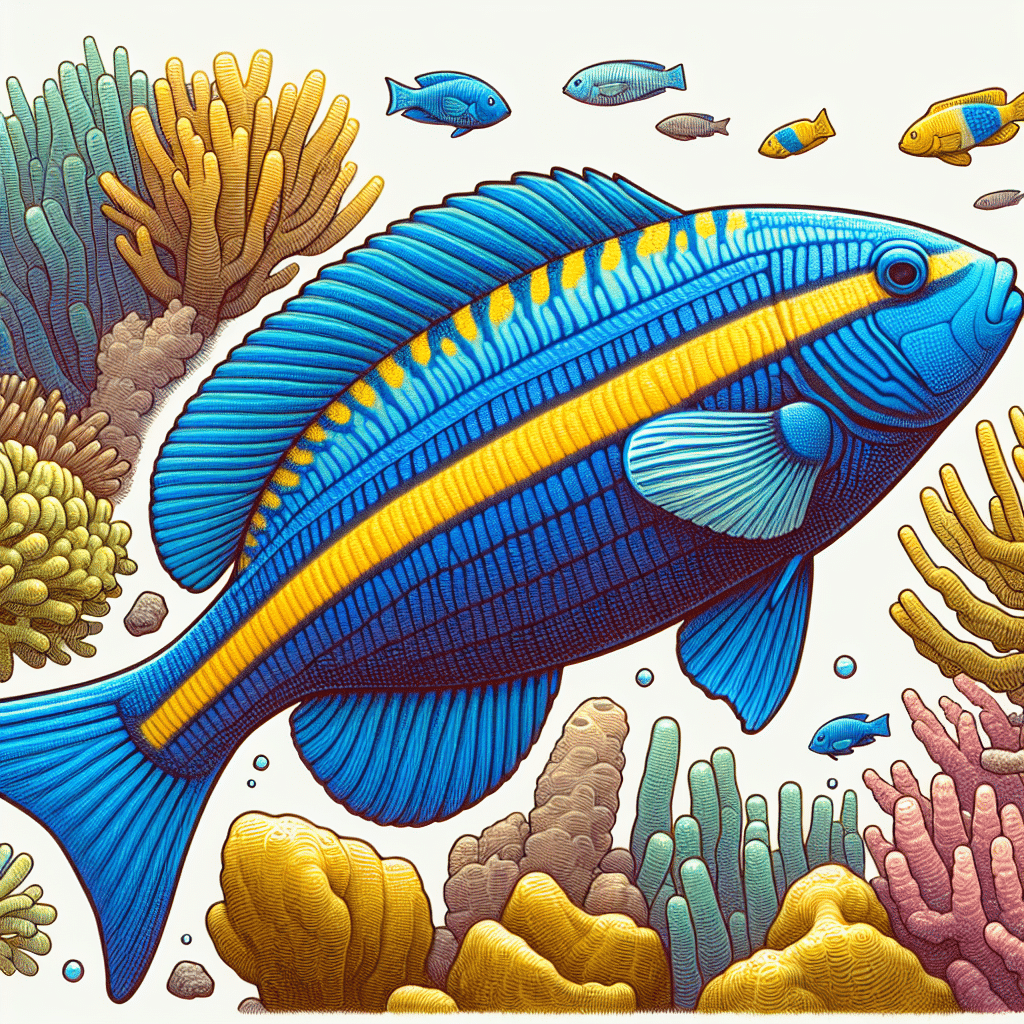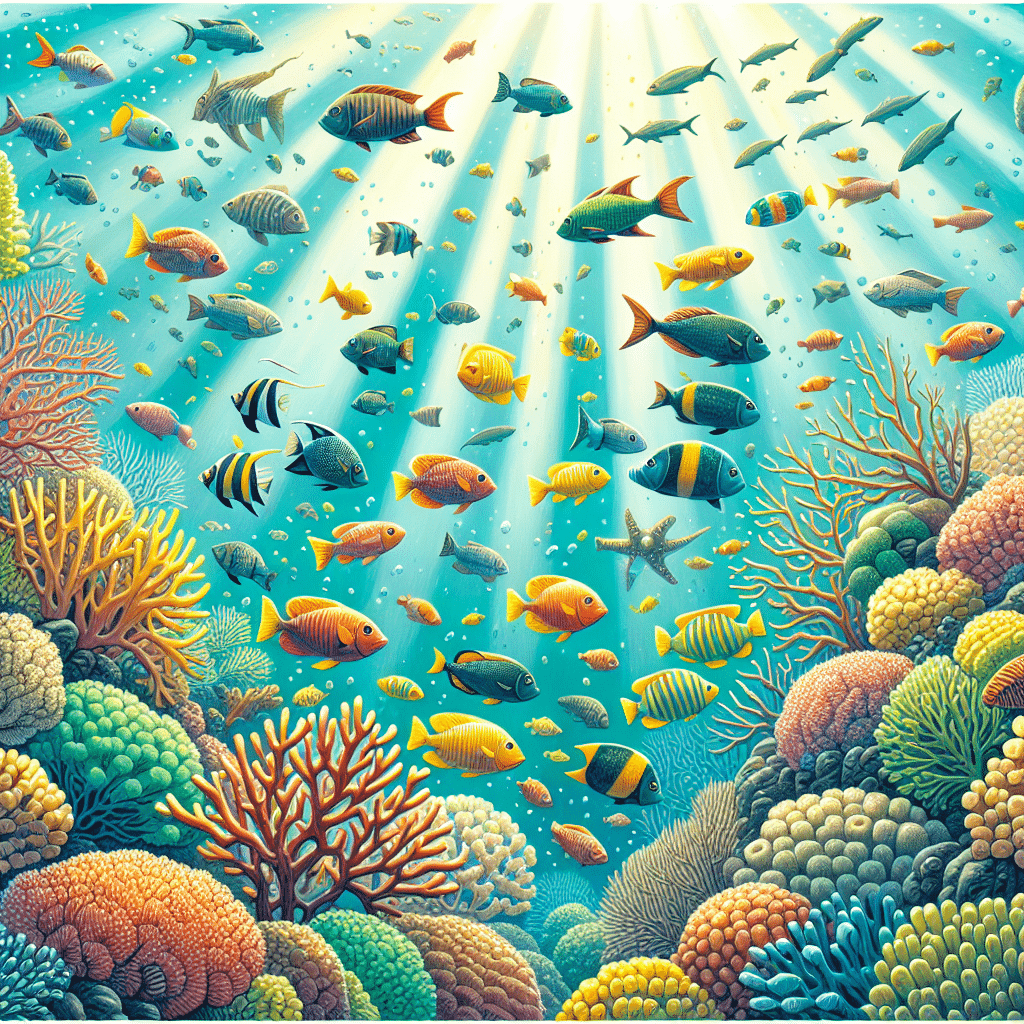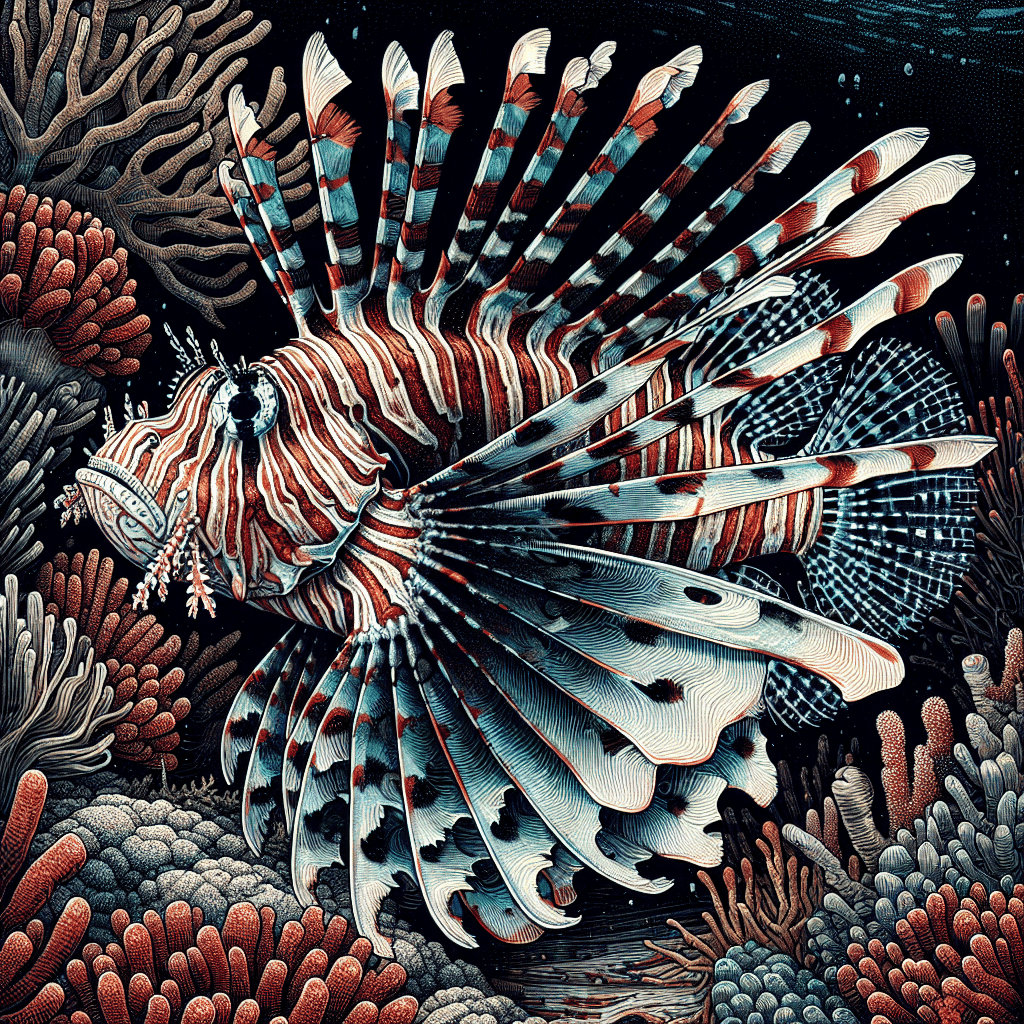Introduction to Cleaner Wrasse
Ecological Role of Cleaner Wrasse
I find the Cleaner Wrasse (Labroides dimidiatus) to be a fascinating marine fish, mainly due to its unique ecological role as a cleaner in coral reef ecosystems. These little fish are not just swimming around aimlessly; they form mutualistic relationships with larger fish by removing parasites and dead tissue from their bodies. This relationship is essential for the health of both parties involved.
Cleaner wrasses operate from designated cleaning stations, which are specific spots on the reef where they attract clients through distinct dancing motions. This behavior helps establish mutual trust, which is crucial for their safety, especially since they are often surrounded by potential predators. Larger fish recognize these wrasses by their colors and shapes, allowing them to access sensitive areas like their gills for cleaning (Happy Pet).
Here’s a quick overview of the Cleaner Wrasse’s ecological role:
| Feature | Description |
|---|---|
| Scientific Name | Labroides dimidiatus |
| Habitat | Coral reefs and rocky areas in tropical waters |
| Cleaning Stations | Fixed spots on the reef where wrasses clean larger fish |
| Cleaning Services | Removal of parasites, dead skin, and excess slime |
The Cleaner Wrasse plays a crucial part in maintaining the health of reef ecosystems. By keeping larger fish clean, they help prevent the spread of parasites and diseases among marine populations. This not only benefits the fish but also promotes a balanced ecosystem overall.
For those of us who keep fish tanks, understanding the ecological role of species like the Cleaner Wrasse can enhance our appreciation for the delicate balance of marine life. If you’re interested in learning more about different types of marine fish, check out our section on marine fish.
Habitat and Distribution
Natural Habitats of Cleaner Wrasse
I’ve always been fascinated by the cleaner wrasse and its unique role in the ecosystem. These little fish primarily inhabit coral reefs and rocky areas throughout tropical waters, especially in the Indo-Pacific region. I’ve learned that they thrive in environments with ample live rock formations, coral outcrops, and crevices that provide shelter and hiding spots from potential predators.
The bluestreak cleaner wrasse, one of the most well-known species, can be found on coral reefs stretching from the Red Sea and Indian Ocean to the western Pacific. This includes stunning locations like Papua New Guinea, Japan, Fiji, and French Polynesia. Interestingly, the bluestreak cleaner wrasse was first recorded in the Kermadec Islands Marine Reserve north of New Zealand in 2015.
| Region | Notable Locations |
|---|---|
| Red Sea | Coral reefs |
| Indian Ocean | Coral reefs |
| Western Pacific | Papua New Guinea, Japan, Fiji, French Polynesia |
Cleaner wrasses play a crucial role in reef ecosystems. They establish cleaning stations where larger fish visit to have parasites and dead skin removed. This mutualistic relationship not only benefits the clients but also provides essential nutrients for the cleaner wrasse. I find it fascinating how these fish attract clients through distinct dancing motions, establishing mutual trust critical for their survival (Happy Pet).
In terms of their population structure, the bluestreak cleaner wrasse has been found to fall into two monophyletic clades. The populations in the Indian Ocean are visually different from those in the western Pacific, particularly in stripe widths. Japanese cleaner wrasses, despite their appearance, belong to the same group as Indian Ocean fish, with both clades overlapping around Papua New Guinea.
For anyone interested in marine fish, including cleaner wrasse, it’s important to understand their natural habitats. This knowledge can greatly enhance the experience of keeping these fish in home aquariums. If you’re looking for more information on different types of marine fish, consider checking out articles on marine fish and other fascinating species like the clownfish or tang.
Mutualistic Relationships
Benefits of Cleaner Wrasse Cleaning Services
The cleaner wrasse, particularly the bluestreak cleaner wrasse, plays a vital role in maintaining the health of coral reef ecosystems through its unique cleaning services. This little fish provides an essential service by feeding on excess slime, dead skin, dead scales, and skin parasites found on larger fish. It’s fascinating how this relationship functions; the wrasse gets a nutritious meal, while the host fish benefit from having their skin parasites removed (Burgers’ Zoo).
Here are some key benefits of the cleaner wrasse’s cleaning services:
| Benefit | Description |
|---|---|
| Parasite Removal | Cleaner wrasses effectively remove parasites that can harm larger fish, promoting their overall health. |
| Dead Tissue Cleanup | They help in cleaning off dead tissue, which can prevent infections and maintain the health of their clients. |
| Nutritional Source | By cleaning other fish, cleaner wrasses gain access to a steady food supply, which is crucial for their survival. |
| Protection from Predators | The mutualistic relationship provides some level of protection for the wrasse, as it is often found in the company of larger fish, which can deter potential predators. |
The relationship is not just one-sided; it’s a classic example of mutualism. The wrasse’s cleaning activities also help the host fish maintain their health, which is critical in crowded reef environments where competition for food can be intense.
Interestingly, the bluestreak cleaner wrasse has to maintain a delicate balance in its behavior. If it takes too many bites from a larger fish, it might scare them away, losing out on future cleaning opportunities. On the other hand, if it doesn’t clean enough, it risks missing out on nutrient-rich food sources. This dance of mutual benefit showcases the complexity and interdependence found in coral reef ecosystems.
In my own experiences as a fish tank hobbyist, having cleaner wrasse in a reef tank not only adds to the biodiversity but also helps keep the tank’s fish healthier. Their presence can be a game changer, especially in maintaining the balance of my tank’s ecosystem. If you’re considering adding one to your setup, check out some of the marine fish options that can coexist well with cleaner wrasse.
Behavioral Insights
Behavioral Patterns of Cleaner Wrasse
As I dive into the fascinating world of cleaner wrasse, I find their behaviors truly captivating. These little fish engage in a variety of unique actions that not only showcase their intelligence but also highlight their essential roles in the reef ecosystem.
Cleaner wrasse are known for their “dancing” behavior, which they use to attract potential clients in need of cleaning services. This display is not just a show; it’s a way for them to advertise and establish themselves as reliable cleaners. They often engage in what researchers call “temporal discounting,” which means they sometimes prioritize immediate rewards over future ones. This behavior can lead to situations where they might seem to cheat their clients by opting for tastier mucus instead of the parasites they are supposed to clean (NCBI).
Interestingly, cleaning wrasse also exhibit social behaviors that help them thrive. They can cooperate with other cleaner wrasse, showing an ability to work in pairs or groups when servicing clients. This social facilitation means that they can improve their cleaning efficiency when in the presence of others. They may even display a form of “third-party punishment,” where they will react negatively if another wrasse tries to cheat a client.
Another fascinating aspect is their approach to clients. Cleaner wrasse often have to overcome their natural shyness to interact with larger fish. They don’t wait for clients to signal readiness; sometimes, they initiate contact themselves, even when it doesn’t yield immediate feeding benefits. This tactile interaction is costly for them as they refrain from eating during the cleaning process, but it provides stress relief for the clients, showing a deeper layer of mutual benefit.
Cleaner wrasse also rely on their cognitive abilities to decide when to cooperate or when to defect. Their feeding preferences can sometimes conflict with their cleaning duties, as they might prefer the mucus from clients to the parasites. They have to learn to resist this temptation to maintain a good reputation among their clients (NCBI).
Lastly, serotonin plays a crucial role in their behavior. Studies show that when serotonin levels are manipulated, it affects their motivation to interact with clients. Higher serotonin levels lead to more frequent cleaning interactions, while lower levels result in decreased engagement. This connection between biochemistry and behavior highlights just how complex their social dynamics are (NCBI).
By understanding the behavioral patterns of cleaner wrasse, I’m not just gaining insights into their unique traits but also appreciating their vital role in maintaining the health of reef ecosystems. For anyone considering keeping these intriguing fish in a reef tank, recognizing their behavior and social needs is crucial for creating a thriving environment. If you’re interested in other marine inhabitants, check out our articles on marine fish or specific species like clownfish and tang.
Importance in Reef Ecosystems
Impact on Coral Reef Communities
I find it fascinating how the cleaner wrasse plays such a crucial role in maintaining healthy coral reef ecosystems. These small fish provide a vital cleaning service to larger fish, removing parasites and dead skin, which not only benefits the fish but helps maintain the overall health of the reef community.
A study conducted over 8.5 years on two patch reefs demonstrated the significant impact of cleaner wrasses. When these fish were removed, the reefs experienced less healthy fish populations, with smaller fish sizes and reduced overall numbers compared to reefs where cleaner wrasses were present (Reefs.com). This clearly shows that their presence is essential for a balanced ecosystem.
Without cleaner wrasses, the dynamics of fish communities can shift dramatically. Their absence disrupts the balance, affecting biodiversity and potentially reshaping the entire reef ecosystem. This is because cleaner wrasses attract other fish to the reef, and removing them leads to a reduction in fish recruitment. This imbalance can alter the ratio of herbivores to algae, causing a cascade of effects on other organisms within the reef.
Here’s a quick overview of the impact of cleaner wrasses on reef ecosystems:
| Impact Category | Effect of Presence | Effect of Absence |
|---|---|---|
| Fish Health | Improved overall health and size | Smaller sizes, less healthy fish |
| Biodiversity | Maintained balance among species | Disruption in species ratios |
| Recruitment of Fish | Increased fish recruitment | Reduced recruitment |
| Ecosystem Balance | Stable ecosystem dynamics | Altered community structure |
It’s essential for us as aquarium enthusiasts to understand the importance of cleaner wrasses. Their removal from natural habitats can lead to serious consequences, and it’s vital to discourage their collection for the aquarium trade. Raising awareness among fellow hobbyists about the role of cleaner wrasses is crucial to protecting these reef ecosystems (Reefs.com).
In addition, mutualistic interactions like the cleaning services provided by cleaner wrasses are sensitive to environmental changes. Disruptions in these relationships can have far-reaching effects on the adaptability of reef ecosystems (BMC Biology). Understanding these dynamics helps us better appreciate the delicate balance of life in our oceans and the need to protect these species.
Feeding Habits and Diet
Dietary Needs of Cleaner Wrasse
When it comes to keeping a cleaner wrasse in my reef tank, understanding their dietary needs is essential for their health and well-being. The cleaner wrasse primarily feeds on ectoparasites and dead tissue from the bodies of other fish. This natural behavior not only provides a cleaning service to its host fish but also ensures a nutritious diet for the wrasse itself.
In an aquarium setting, it’s important to replicate their natural feeding habits as closely as possible. Here’s a breakdown of their dietary requirements:
| Food Type | Description | Frequency |
|---|---|---|
| Marine Flake Foods | High-quality flakes or pellets rich in protein. | Daily |
| Frozen Foods | Offer foods like brine shrimp and mysis shrimp. | 2-3 times a week |
| Live Foods | Chopped seafood can also be provided occasionally. | Weekly |
A varied diet is crucial to keep my cleaner wrasse healthy and thriving. For example, supplementing their meals with frozen or live foods ensures that they receive essential nutrients that may not be present in dry foods alone.
Cleaner wrasses, like the bluestreak cleaner wrasse, usually engage in their cleaning behavior at designated “cleaning stations” within the reef where they perform a dance-like motion to attract client fish. This unique feeding practice allows them to consume excess slimes, dead skin, dead scales, and skin parasites, which is quite fascinating to observe (Burgers’ Zoo).
In my experience, it’s also important to ensure that the cleaner wrasse has enough space and the right environment to exhibit its natural behaviors. Providing hiding spots and a well-maintained tank can help reduce stress and encourage healthy feeding habits.
For more insights into maintaining a thriving aquarium, I recommend checking out information on marine fish and other compatible species that can coexist with cleaner wrasses, such as the clownfish or tang.
Care and Maintenance
Health Considerations for Cleaner Wrasse
Taking care of my cleaner wrasse is essential to ensure they thrive in my reef tank. These fish are generally hardy, but they need stable and clean water conditions to remain healthy. I keep an eye out for common health issues such as parasitic infections like white spot (ich) and bacterial infections, which can arise from poor water quality or stress. Regularly checking for signs of illness, such as loss of appetite, lethargy, or unusual swimming patterns, is crucial for their well-being (Happy Pet).
It’s also important to monitor the water parameters closely. Here’s a handy table of the ideal water conditions for cleaner wrasse:
| Parameter | Ideal Range |
|---|---|
| Temperature | 75°F to 82°F (24°C to 28°C) |
| pH | 8.1 to 8.4 |
| Salinity | 1.020 to 1.025 |
| Ammonia/Nitrite | 0 ppm |
| Nitrate | < 20 ppm |
In case my cleaner wrasse develops fin rot, I know that it can be treated with antibiotic medications and improved water conditions. Trimming any affected fins is a good idea if necessary. Luckily, cleaner wrasses are generally reef-safe and contribute positively to the health of my corals and other fish by cleaning parasites off them (Happy Pet).
The bluestreak cleaner wrasse, in particular, feeds on excess slime, dead skin, dead scales, and skin parasites of larger fish, offering them a cleaning service while benefiting from the food source. This symbiotic relationship is fascinating; the wrasse gets food and protection, while the host fish enjoy relief from irritating parasites (Burgers’ Zoo).
Ultimately, regular observation and maintaining optimal water quality are key to keeping my cleaner wrasse healthy and happy in my aquarium.
Aquarium Considerations
Keeping Cleaner Wrasse in Home Aquariums
As a reef tank hobbyist, I find the Cleaner Wrasse to be an exciting addition to my aquarium. These little fish are not only colorful but also play a vital role in maintaining the health of other fish. Before I dive into keeping them, I want to share some essential tips and considerations for anyone looking to house a Cleaner Wrasse in their home aquarium.
Habitat Requirements
Cleaner Wrasses prefer environments that mimic their natural habitats, which consist of coral reefs and rocky areas. They thrive in tanks with plenty of live rock formations and crevices. This setup not only provides hiding places but also helps them establish cleaning stations where they can perform their cleaning services.
| Ideal Tank Conditions | Recommended Values |
|---|---|
| Tank Size | Minimum of 30 gallons |
| Water Temperature | 75°F to 82°F (24°C to 28°C) |
| Salinity | 1.020 to 1.025 specific gravity |
| pH Level | 8.1 to 8.4 |
| Ammonia/Nitrite/Nitrate | 0 ppm/0 ppm/less than 20 ppm |
Dietary Needs
Cleaner Wrasses primarily feed on parasites, dead skin, and excess slime from larger fish. In the aquarium, it’s essential to provide them with a varied diet that includes high-quality flakes, frozen foods, and specialty foods designed for marine fish. This ensures they remain healthy and fulfill their cleaning role effectively.
Health Considerations
These fish are generally hardy if kept in stable, clean water conditions. However, they can be susceptible to parasitic infections like ich and bacterial infections, especially in poor water quality. Regular observation for signs of sickness, such as loss of appetite, lethargy, or abnormal swimming behavior, is crucial for their well-being (Happy Pet).
Common health issues and solutions include:
| Health Issue | Symptoms | Solution |
|---|---|---|
| Ich (White Spot) | White spots on body | Quarantine and treat with medication |
| Fin Rot | Frayed or discolored fins | Antibiotics and improved water conditions |
| Stress-related issues | Lethargy, hiding behavior | Improve tank conditions and reduce aggression from tank mates |
Tank Mates
Cleaner Wrasses are generally reef-safe and work well with various marine fish. They help maintain the health of corals and other fish by cleaning parasites. However, it’s crucial to avoid pairing them with aggressive fish that may harass them.
If you’re considering adding a Cleaner Wrasse to your aquarium, make sure to create an environment that suits their needs. With proper care and attention, these fascinating fish can thrive in your reef tank, providing valuable cleaning services to their fellow inhabitants. For more information on marine fish suitable for aquariums, check out our article on marine fish.



